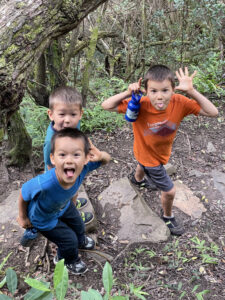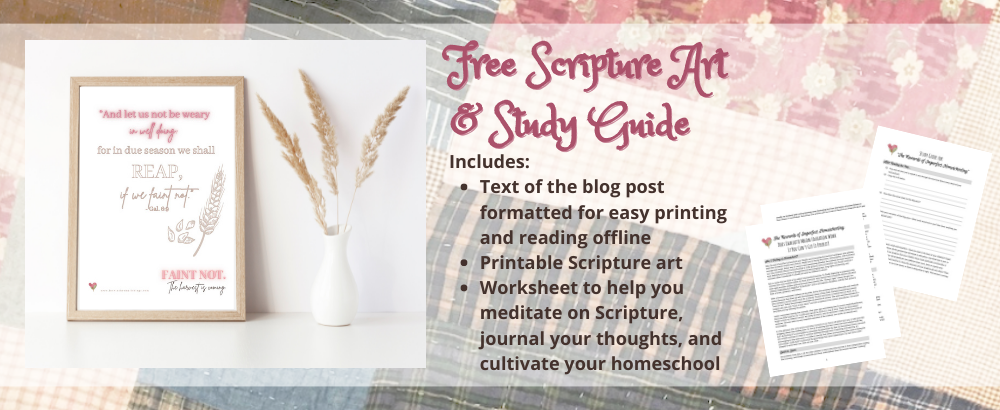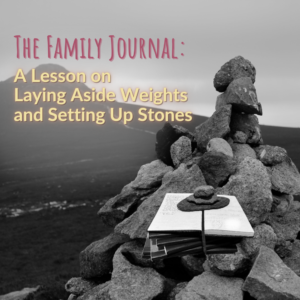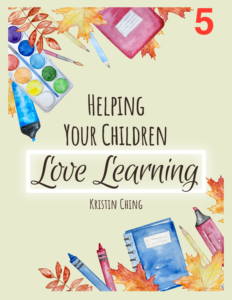Does Charlotte Mason Education Work If You Can’t Get It Perfect?
Ahh, the end of another homeschool year. Maybe you’re browsing homeschool catalogues and websites with their hundreds of shiny new choices. Maybe you’re facing discontent, slow progress, and frustration amongst the troops. Either way, it’s easy to start questioning whether the method you have chosen (in our case, Charlotte Mason homeschooling) is really going to work and whether you should continue. I have definitely had my share of disorganized and discouraging days, long nights of planning, and moments when I wondered if I should just send my children to school.
But as I enter the last third of my oldest’s homeschool journey, I’m finally beginning to experience the rewards that many mothers before me have promised. They claimed that a Charlotte Mason education done right provides children with all the tools they need for life. “Doing it right” means we give our children challenging but delightful “living books” and an atmosphere, discipline, and life that spread a feast of truth, goodness, and beauty.
With a firmness motivated I believe not by pride, but by the certainty that her philosophy and methods worked because they lined up with the God-given nature of the child, Charlotte insisted that parents who wanted to use her system must do so exactly. To pick and choose a method here or there, or to “more or less” follow the principles would give no promise of success. She even used the example of a surgeon who was only “more or less clean,” and not scrupulous in his sanitary procedures—he would very likely end up infecting his patient.
I think I remember hearing that example a few years ago and thinking that if success required perfection, there was little hope for me. I could never get all my ducks in a row at once. There are times when I forget to have my children narrate. We rarely do exams, and we still haven’t really started our books of centuries. Yet even with my very imperfect execution of the method, our results are already very encouraging.
If a few glimpses into some joyous everyday moments in our home will either bore you or will seem like bragging, please stop reading now. I’m not at all claiming that this is what our home always looks like, but I do find that it’s more helpful to remember the good than the bad. As homeschool moms, we need lots of faith and hope in order to continue faithfully through years of planting and watering. It’s encouraging to stop every once in a while to see the fruit others are harvesting after years of doing the same thing. I really hadn’t noticed all the good things that were happening in my own home until I stopped to write them out. Here are just a few . . .
Lunch & Learn
At lunchtime most days, I ask the older children to share what they learned in their independent reading that morning, and though occasionally (on those undisciplined days) the answer has been “nothing,” usually my husband and I end up learning some fascinating fact from the history of ancient Britain or from physics or ornithology. Sometimes one of them will run to get his literature or geography book and read a passage to us that was just too good to keep to themselves.
Sometimes when a younger one is reading aloud from a book that the older ones read years ago, I can see the older sibling’s ears prick up with nostalgia. They might jump in and add other information about the particular animal or battle their sibling is reading about, facts they have since learned from their other school books, library books, or the encyclopedia.
Pilgrim’s Progress Scroll
I’m not sure where I got the idea, but another thing that’s working really well for us is to have everyone listen to the Answers in Genesis dramatized audiobook of Pilgrim’s Progress and draw pictures of the story on a long paper roll “scroll.” The children take turns drawing the different episodes, shifting the scroll and rotating around the table as necessary. The audiobook chapters are fairly short, so the first child is still finishing up his drawings and coloring them while the next one starts. Because there are no clear divisions in the audio to mark when it’s the next child’s turn, I keep an eye on the tracks as they play on my computer’s Music app. Sometimes I hand the children sticky notes on which I’ve written the episode titles or names of main characters so they can copy them onto their drawings.
Even though I’m sure the little ones don’t understand every word of the story, the sound effects and great characterization of voices make this audiobook enjoyable for all ages. I pause to explain the archaic vocabulary only once in a while, but to judge from some of the amazing visual narrations that everyone from the 14-year-old to the 7-year-old has been able to draw, they are definitely comprehending and having their imaginations fed.
Self-guided Unit Studies
Unit studies are often touted as a great way to learn because all areas of knowledge (science, history, literature, art, etc.) stem from one central topic, making it easier and more interesting for children to learn and relate information. Often there are lots of hands-on projects, activities, and research reports. In my own homeschooling as a child, we used mostly this method throughout middle and high school, with units centered around passages of Scripture. I do think it helped nurture my love for learning and showed me very clearly that all areas of knowledge are inter-related, with Scriptural truth being the standard and source of all wisdom.
But even though I know many homeschoolers have been successful with the method, my own experience using it growing up left me feeling that I prefer to learn and teach by making steady progress through each subject in an order that makes sense for that subject. Charlotte Mason actually cautioned against unit studies in which the teacher presents the student with ready-made, often artificial connections between subjects. She recommended instead that we allow students to experience the joy of learning by noticing the relations between different areas of study for themselves.
But aside from philosophical concerns about the method itself as a primary means of homeschooling, I have realized that the unit studies mostly being sold today, with their emphasis on projects, crafts, dramas, and other “hands on learning,” are definitely not for me. I never could find the motivation to do finger painting, and I have a secret dread of googly eyes and pipe cleaners. I’ve learned to accept the fact that I just don’t have the time or mental energy to plan art projects and elaborate holiday-themed celebrations and studies. But sometimes I would feel a twinge of guilt that my children are missing out because I don’t do all those fun “mom projects” with them.
Lately, though, I’ve realized that my children actually do unit studies of a sort on their own whenever they are really interested in a topic, and that these are even more valuable to their education than any studies I would have designed for them. For example, Trailman, our oldest, has checked out practically every book available at our public library on airplanes and drones at least once, and at one time (frustrated with the limited offerings there), he was writing his own book explaining the scientific principles of flight. He loves to talk airplane history, and actually asked for a college textbook about aircraft design for his birthday—something I would have never required him to study.
Some of our other children are interested in architecture, birds, butterflies, or cowboys, and they read everything they can get their hands on about those subjects, create their own drawings or dramas, and pick up a fair amount of related history and science in the process. While I might look for extra resources for them to explore in their chosen topics, I don’t think that finding a “dinosaur unit study” for the one interested in dinos or a “cowboy unit study” for the little boys would really have any benefit—the contrived activities might just squelch their natural desire to pursue the topic on their own.
Nature Study
I hesitate to even write about nature study because it’s one of those areas that we do very imperfectly, especially this last year as we’ve focused more on math and language. I know many other moms feel the same, since it’s not a subject most of us grew up with, and we aren’t exactly sure how to do a nature walk or nature notebook. It takes time to develop new habits of observing and recording what we see and hear, of actually seeing and hearing in anything more than generalities.
One thing that works for us is having lots of field guides. When we first moved to Hawaii, I was concerned that I wouldn’t be able to find appropriate field guides for the unique wildlife here, but I was blessed to hit on several great ones at our local library’s used book store. We have guides for local wildlife, sea creatures, birds, bugs, trees, and flowers, and more general guides for mammals, butterflies, shells, and rocks. The children are constantly referencing these guides on their own initiative to settle disagreements about which bird that is in the front yard or to figure out if a certain bug is good or bad.
I may have briefly shown the older children how to use the field guides at some point, but mostly they have picked this up on their own after being told a few times that they could look up something they’d drawn in their nature journals. Each of the school-age children has a spiral art notebook with thick drawing paper that works for pencil, pen, colored pencils, or watercolor. The youngest students can just do simple labeled drawings, but for older students each entry is supposed to include sentence-length narrations of their observations with illustrations.
I’d like to assign weekly entries, but because it didn’t fit on everyone’s regular schedule this year, I’ve only occasionally remembered to assign and inspect their journals. Still, they have learned (because I’ve sometimes required it) that even in what appears to be a plain plot of grass, there is always something new to observe.
Another thing that worked was doing what in Charlotte Mason education is called “special studies.” Last school year we had a different focus each term for nature studies together. One term we read a book about clouds and learned to identify different types. Another term we studied spiders, reading several different stories from some well-written nature readers. One of their favorite terms, we watched a number of the free, very detailed videos on drawing birds available at johnmuirlaws.com (this link goes directly to one of the most helpful videos).
Though we’ve done nature studies as a family, each of us has some topics we enjoy more than others. I enjoy getting out my watercolors once in a great while and painting a scene at the beach or in the garden. I write out my observations with a micron pen. Trailman would rather be doing science or history, and his entries tend to be quickly scribbled drawings done in pencil, with only as much writing as I require. Tarzan is our resident bird expert, able to identify practically every bird in his huge Field Guide to the Birds of North America. Apart from his nature notebook, he decided to fill a sketchbook with drawings of different birds, and he has even sold several of his bird paintings to people we know.
Sir Knight decided with a friend at church to have a contest to see who can draw the largest number of realistic animals—so for the past week he’s had multiple encyclopedias and reference books out trying to find models for his drawings. The younger children are all at different levels in their observation, drawing, and writing skills, but I’m hopeful that if we just continue filling their imagination with good nature stories and building the habit of observing details, they will all learn to appreciate the wonders of God’s creation.
Time to Play
With seven boys in the family, it’s not surprising that our backyard is often the set for Revolutionary battles, Lewis & Clark expeditions, or Wild Brothers escapades. But my daughter must have gotten her way one day last year, because instead of swashbuckling bravado, they were playing wedding. Six-year-old Cowboy, dressed up in his Sunday best with dimpled smile and newly missing front tooth, ran up and informed me that he was going to marry his ten-year-old sister. Later, while I was teaching piano to Tarzan, Princess came in with her fanciest, almost outgrown princess gown, several necklaces and hair clips, and an eight-year-old beautician (Sir Knight) who was helping her finish getting ready for the “wedding.” Meanwhile, the four-year-old videographer (Rambo) used an old remote control as his camera to record it all. We had to ask them all to be quiet because we couldn’t focus on our piano lesson with all the laughter.
Tarzan ended up taking a real video of the ceremony with his own camera (bought with money he earned mostly by doing yardwork and cleaning for neighbors), and at supper time they all gathered around one end of the table and watched it, roaring with laughter.
After dinner cleanup, they apparently decided that the bride and groom needed to have their whole life planned out. They scattered around the family room with pens or pencils and paper in hand, each designing something for the new couple—Trailman drafted plans for their yacht, Tarzan drew the blueprint for their house, Princess designed their garden, Sir Knight sketched the furniture, and Cowboy planned out all the roads and buildings in their town (he even wanted to continue working on it during our Mommy time, and after finishing his popsicle treat, asked me how to spell the names for the various buildings and shops).
All of this was done without one bit of prompting, guidance, or input from me beyond giving the spelling of words when asked—and suggesting that they take the city planning project a bit further sometime and try to figure out where different buildings would best fit in the miniature geography of our back yard. But they never did, and that was fine. I’m seeing firsthand what Charlotte said and what others have repeated in different words—the teacher must train by masterly inactivity, and there is no true education but self-education. No matter how full our schedules with lessons, music practice, chores, etc., the children must have free time to play and process what they are learning in their own way, without our constant direction. When they do, their God-given creativity will blossom.
Have we always “done it right”? Hardly. More times than I’d care to admit, the atmosphere of my heart and our home is not completely full of love, joy, and peace. More often than not, one or other of us is lacking in discipline, and that causes us to miss out on part of the feast so carefully planned in our weekly schedule. Once in a while I even lazily (or through fear of the great STANDARDIZED TEST) offer up some hastily googled worksheet that I know is dead and meaningless.
But I hope these glimpses into our home have encouraged you to trust that if you are faithful to keep planting the good seed of living ideas and cultivating, weeding, and watering the soil of your children’s heart, they will eventually bring forth the fruit God created them to bear. Keep loving in the small things, Mama—it’s worth it!






